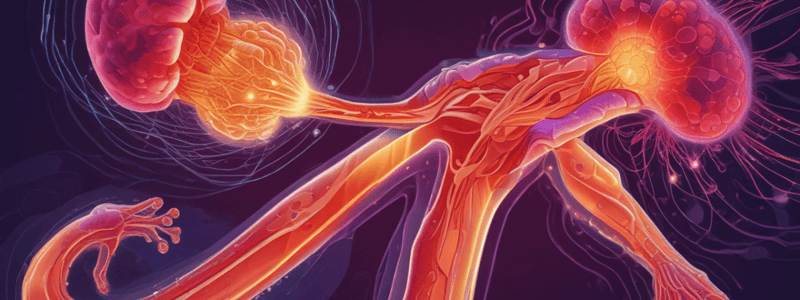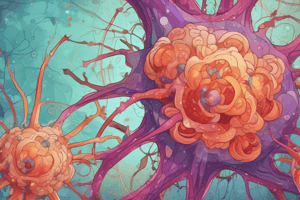Podcast
Questions and Answers
What is the primary goal of the inflammatory response?
What is the primary goal of the inflammatory response?
To recruit immune cells, inactivate or destroy invaders, and facilitate repair
What type of cells release histamine in response to membrane damage?
What type of cells release histamine in response to membrane damage?
Mast cells
What is the effect of histamine on endothelial cells?
What is the effect of histamine on endothelial cells?
It causes them to contract, becoming more porous
What type of cells migrate through the porous endothelium into the affected area?
What type of cells migrate through the porous endothelium into the affected area?
What is the purpose of chemokines released during inflammation?
What is the purpose of chemokines released during inflammation?
What are the three main types of stimuli that can trigger an inflammatory response?
What are the three main types of stimuli that can trigger an inflammatory response?
What is the result of vasodilation during inflammation?
What is the result of vasodilation during inflammation?
Can inflammation occur in the absence of an infection?
Can inflammation occur in the absence of an infection?
What is the role of neutrophils in the inflammatory response?
What is the role of neutrophils in the inflammatory response?
What is the result of vasodilation in inflammation?
What is the result of vasodilation in inflammation?
What is the function of cytokines in inflammation?
What is the function of cytokines in inflammation?
What is the role of dendritic cells in the immune response?
What is the role of dendritic cells in the immune response?
What is the result of monocytes becoming activated in inflammation?
What is the result of monocytes becoming activated in inflammation?
What is the effect of inflammation on coagulation?
What is the effect of inflammation on coagulation?
What is the role of fibroblasts in inflammation?
What is the role of fibroblasts in inflammation?
What is the result of stimulation of fibroblasts in inflammation?
What is the result of stimulation of fibroblasts in inflammation?
What are the four classic signs of inflammation?
What are the four classic signs of inflammation?
What is the best-case scenario for inflammatory mediators?
What is the best-case scenario for inflammatory mediators?
What can happen in the worst-case scenario of local inflammation?
What can happen in the worst-case scenario of local inflammation?
What is Systemic Inflammatory Response Syndrome (SIRS) characterized by?
What is Systemic Inflammatory Response Syndrome (SIRS) characterized by?
What are some examples of stressors that can trigger SIRS?
What are some examples of stressors that can trigger SIRS?
What is the key difference between local and systemic inflammation?
What is the key difference between local and systemic inflammation?
What is the main implication of SIRS?
What is the main implication of SIRS?
whats is SIRS criteria
whats is SIRS criteria
Flashcards are hidden until you start studying
Study Notes
Introduction to Inflammation
- Inflammation is the host's response to a detrimental stimulus, such as chemical, mechanical, or pathogenic factors.
- The goal of inflammation is to recruit immune cells, inactivate or destroy invaders, and facilitate repair.
Inflammation Process
- Injured cells release chemokines, signaling blood vessels to vasodilate and recruit white blood cells.
- Mast cells release histamine in response to membrane damage, causing endothelial cells to contract and become more porous.
- Histamine induces vasodilation, allowing monocytes and neutrophils to migrate through the porous endothelium into the affected area.
- Monocytes become activated macrophages, and neutrophils act as phagocytes, eating particles and antigens and releasing cytokines.
Pathophysiology of Inflammation
- Inflammation leads to vasodilation, summoning more white cells to the area, and stimulating fibroblasts to produce collagen.
- Inflammation also triggers the release of catecholamines (adrenaline and noradrenaline), alters coagulation, and creates a pro-coagulation environment.
Dendritic Cells
- Dendritic cells are antigen-presenting cells that detect, engulf, and inform the adaptive immune response, allowing naïve lymphocytes to become antibodies.
Signs of Inflammation
- The classic signs of inflammation are redness (rubor), heat/fever (calor), pain (dolor), and swelling (tumor).
Local vs. Systemic Inflammation
- In the best-case scenario, inflammatory mediators recruit immune cells to destroy pathogens and repair the area.
- In the worst-case scenario, local inflammation becomes systemic or attacks a distal system.
- Systemic Inflammatory Response Syndrome (SIRS) is an out-of-proportion defense response to a stressor, such as infection, surgery, trauma, tumor, ischemia, etc.
- SIRS is defined by the presence of two or more of the following conditions: body temperature > 38°C or < 36°C, heart rate > 90 beats/min, respiratory rate > 20 breaths/min, white blood cell count > 12,000 cells/mm³ or < 4,000 cells/mm³, or > 10% bands.
Studying That Suits You
Use AI to generate personalized quizzes and flashcards to suit your learning preferences.




